Introduction
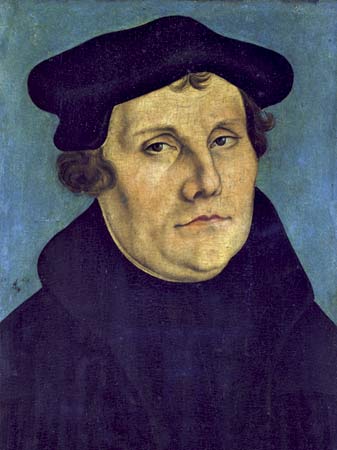
Morning Blessing: I thank You, my heavenly Father, through Jesus Christ, Your dear Son, that You have kept me this night from all harm and danger; and I pray that You would keep me this day also from sin and every evil, that all my doings and life may please You. For into Your hands I commend myself, my body and soul, and all things. Let Your holy angel be with me, that the evil foe may have no power over me. Amen. — The Small Catechism: Daily Prayers.
As you may remember, the final project for Christian Devotional Classics at Evangelical Seminary birthed this series. The student who presented on Martin Luther (1483-1546) and A Simple Way to Pray (. . . for Master Peter the Barber) (1535) began the class with a devotional including a Morning Blessing, a consideration of A Mighty Fortress is our God (more below), The Apostle’s Creed, and an Evening Blessing (at the end of the post). As an Emerging Scholars Network blog post, I apologize for only beginning to scratch the surface. I commend to you pieces by Christianity Today and the Christian Classics Ethereal Library as additional on-line resources. If you have recommendations, please share them in the comments section. Thank-you.
Martin Luther (1483-1546)
Martin Luther was born on November 10, 1483, to Hans and Margaret Luder in Eisleben, Germany. While Christopher Columbus was crossing the ocean blue and “finding the Americas” (1492) instead of a new trade route to East, Martin’s father was a miner. In 1497 Martin studied at a monastery in Madgdeburg connected with the Brethren of the Common Life Order. Many famous men had attended the school, including Erasmus (1466 – 1536), a future antagonist, and Thomas à Kempis (c. 1380 – 1471), author of The Imitation of Christ — the focus of an earlier post. Due to the expense of this school, his parents transferred Martin to Eisenach. While in Eisenach, Martin was cared for by a woman in the community. In 1502 he received a Bachelor’s Degree from Erfurt and his father invested in Martin’s law education.
July 2, 1505: “The Thunderstorm” that changed the world
Martin was “paralyzed” by a thunderstorm. Thinking that a tremendous storm in which he found himself represented God’s judgment upon him, he cried out to St. Anne (i.e., patron saint of the miners) and swore to become a monk if he survived the storm. This “Anfectung” (an intense spiritual struggle/crisis) afflicted him throughout his life. Two weeks after the storm he held a party and gave away his law books. His father refused to give permission to this change of vocation and almost disowned him.
As this story illustrates, Martin Luther was a man of strong emotion who believed not only in the existence of the spiritual realm, but the power of it. There are even stories of him later in life in which he understood himself as “wrestling with the devil.” Below is a timeline of what came after being ordained (1507) and becoming part of the academic system (1509 lecturer at Erfurt after receiving a B.A. in Bible). But before laying out the “beginning of the Reformation”, let’s take a step back for a little more of the context. Richard J. Woods writes in Christian Spirituality: God’s Presence Through the Ages:
The Protestant Reformation did not occur suddenly in 1517 when Martin Luther tacked his Ninety-five Theses to the church door in Wittenberg . . . the movement towards reform had a long history in the late medieval Church” — Richard J. Woods. Christian Spirituality: God’s Presence Through the Ages. Expanded edition. Maryknoll, NY: Orbis Books, 2006. p.186.
Although Martin was not starting a movement, he was seeking opportunity to share what God was teaching him. There was a unique political and religious instability in the Germanic regions after the trial and execution of Jan Hus (c. 1369-1415). Maybe the resultant Hussite Wars (1420-1434) and the papal instability evidenced by the Western Schism (1378 to 1417) led princes/kings to have more boldness to enter political/religious conflicts — devastating Europe for the next several hundred years. Note: Before the time of Hus, Peter Waldo (c. 1140 – c. 1218) criticized the selling of indulgences and various other practices in the Roman Catholic Church. His labors led to the Waldensian movement in southeastern France. Due to centuries of persecution, remnants of the movement allied with the Reformation when it arose in Switzerland.
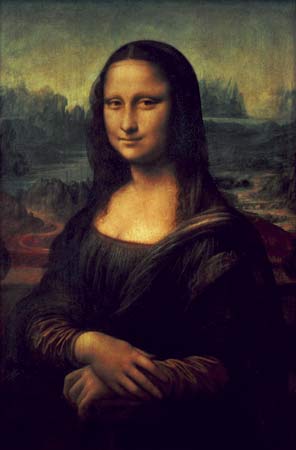
Part of the Middle Ages being superseded by the Renaissance (1450 – 1600) was the presence of great artists such as Leonardo da Vinci (1452 – 1519), who began painting the Mona Lisa in 1503, and Michaelango (1475 – 1564), whose requirement of additional money for the completion of the Sistine Chapel led to the selling of indulgences. Another powerful piece of the period was the unleashing of mass communication through the development of the printing press (~ 1439). Quickly art, commentary, culture, and the Word spread in ways it never did before. It is also hard to under-emphasize the Portuguese and Spanish exploration/conquest with the circling of the globe by Magellan (1519 – 1522) and their presence in the Americas.
Returning to Martin Luther’s time line . . .
- 1507: Martin Luther’s ordination was followed by receiving both a B.A. in Bible and assuming the role of lecturer at Erfurt in 1509.
- 1510: Tied to dropping off papers for his superior (i.e., Johann von Staupitz), Luther took a pilgrimage to Rome. His superior’s hope was for the time to be one of holy reflection which appeased his conscience. But instead Luther had a strong reaction to the corruption of the church he found in Rome.
- 1512: Luther received his doctorate in theology.
- 1513: As a lecturer in philosophy at Wittenberg, Luther began to develop his thinking through the study of Augustine. He tried to reconcile scholastics with Scripture, in particular the issue of “the angry God.” He taught a number of books of the Bible including Romans, Galatians, and Genesis.
- Historical Note: The same year Machiavelli published The Prince.
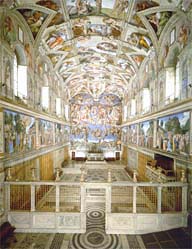
Click here for a virtual visit of the Sistine Chapel. “Sistine Chapel”. Photograph. Web. 18 Aug 2013. <http://mv.vatican.va/3_EN/pages/CSN/CSN_Main.html> - 1517: On October 31, the Ninety-Five Theses were nailed to the Wittenberg Church as an invitation to debate. Luther was not attacking the pope. His main problem was the sale of indulgences by Leo X in order to pay for the Sistine Chapel by Michelangelo.
- “As soon as the coin in the coffer rings, the soul form purgatory springs.”
- Luther thought that the Pope would end the sale of indulgences.
- Historical Note: Purgatory as a physical space between heaven and hell after death began to develop as a popular concept in the late 12th century.
- 1518: Luther dug into Romans 1:17, wrestling with what it meant to achieve the “righteousness of God.” He hated the righteous God who hates sinner. But while teaching . . .
- “At last meditating day and night, by the mercy of God, I began to understand that the righteousness of God is that through which the righteous live by a gift of God, namely by faith. Here I felt as if I were entirely born again and had entered paradise itself through the gates that had been flung open.”
- The beginning of the “5 Solas”, which undergirded the distinguishing doctrine of the Reformational perspective from that of the Roman Catholic Church.
- Sola fide: Faith Alone — In many ways this doctrine launched the Reformation. Luther considered sola fide the “doctrine by which the church stands or falls.”
- Sola scriptura: Scripture Alone.
- Sola gratia: Grace Alone.
- Sola Christo: Christ Alone
- Sola deo Gloria: Glory to God Alone.
- 1520: Luther’s To the Christian Nobility of the German Nation and On the Babylonian Captivity of the Church focused upon “the priesthood of all believers. This significant Reformation doctrine, that all baptized Christians are “priests” and spiritual”, stems from I Peter 2:9
- 1521: The Diet of Worms
- Safe travel arranged by Frederick the Wise, Duke of Saxony.
- Luther expected dialogue regarding his developing perspective, but instead found an Inquisition similar to what John Hus faced.
- “Are these your writings?”
- “Do you recant?”
- Luther asked to have a day to think things over. His “legendary” response was:
- “Unless I am convinced by the testimony of the Scriptures or by clear reason (for I do not trust either in the pope or in councils alone, since it is well known that they have often erred and contradicted themselves), I am bound by the Scriptures I have quoted and my conscience is captive to the Word of God. I cannot and will not recant anything, since it is neither safe nor right to go against conscience. May God help me. Amen.”
- Following the Diet of Worms, Luther was placed on an imperial ban.
- 1521-1522: “Kidnapped” by Frederick the Wise and housed at the Castle of Wartburg.
- Luther translated the Greek New Testament into German in three months.
- Furthermore, he refined his thoughts on vocation
- “The prince should think: Christ has served me and made everything to follow him; therefore, I should also serve my neighbor, protect him and everything that belongs to him. That is why God has given me this office, and I have it that I might serve him. That would be a good prince and ruler. When a prince sees his neighbor oppressed, he should think: That concerns me! I must protect and shield my neighbor. . . . The same is true for shoemaker, tailor, scribe, or reader. If he is a Christian tailor, he will say: I make these clothes because God has bidden me do so, so that I can earn a living, so that I can help and serve my neighbor. When a Christian does not serve the other, God is not present; that is not Christian living.” — Martin Luther, “Sermon in the Castle Church at Weimar” (25 October 1522, Saturday after the Eighteenth Sunday after Trinity), in D. Martin Luthers Werke: Kritische Gesamtausgabe, 60 vols. (Weimar: Herman Böhlaus Nachfolger, 1883-1980) 10/3:382 (my translation). Found in Gaiser, Frederick J. “What Luther Didn’t Say about Vocation.” Word & World from Lutheran Seminary.Volume 25, Number 4. Fall 2005, 359.[1]
- AND assumed Junker Jorg as a covert name to be used “when necessary.”
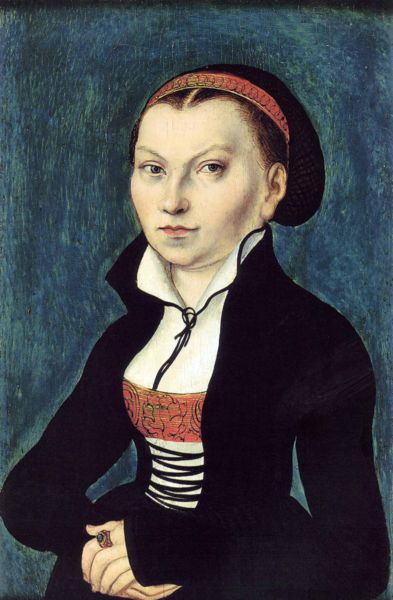
Portrait of Katharina von Bora by Lucas Cranach the Elder, 1526 Oil on panel, Warburg-Stiftung, Eisenach, Germany. Source: Wikipedia. - June 13, 1525: Luther married Katharina von Bora (1499 – 1552), a runaway nun. By doing such he created a precedence for pastoral marriage and a model for family life in the Reformational movement.
- In addition to managing the household, Katharina bore six children: Johannes (Hans) (1526-1575), Elizabeth (1527-28), Magdalena (1529-42), Martin Jr. (1531-1565), Paul (1533-1593), and Margarete (1534-70). In 1539 she had a miscarriage. In addition, Katharina and Martin raised four orphan children. Although she faced a number difficulties after Martin passed away in 1546, she pressed on with incredible strength.
- December 1525: Luther published On the Bondage of the Will in response to Erasmus’ On Free Will (1524), which challenged Luther’s understanding of the effects of “The Fall” upon the will. The Reformation debate over the issue of free will and predestination was “on the table” and the argument was not pretty.
- 1529: The Small Catechism was written for the training of children in the essentials of the faith. The Large Catechism was written for the training of clergy.
- 1530: The Augsburg Confession was written as the Lutheran statement of faith in response to the request given by Holy Roman Emperor Charles V. Due to the imperial ban, Luther was unable to be a direct participant in its fashioning. That responsibility fell to his close colleague and friend Philipp Melanchton (1497 – 19 April 1560), a professor at the University of Wittenberg. The document continues to be an essential to Lutheranism.
- Historical Note: written before the Anglican 39 Articles (1563). King Henry VIII and the Church of England broke away from the Roman Catholic Church in 1531 – 1532.
- 1535: During the year of the publication of A Simple Way to Pray (. . . for Master Peter the Barber), a group of radical, millennialist Anabaptists took Münster, Germany, seeking to establish a theocracy. The “Münster Rebellion” ended in violence and left a dark mark on Anabaptist history.
- Historical Note: A year later, John Calvin (1509 – 1564) published the first edition of the Institutes of the Christian Religion and unexpectedly became part of the reform movement in Geneva. Although it does not appear that they every met, they came to and advocated a number of the same Reformation doctrines. Luther and Calvin continue to have a strong influence not only through collections of their sermons and writings, but also the various documents, individuals, movements, and structures they led/inspired.
- Martin Luther passed away on February 18, 1546. By the time of his death, the Roman Catholic Church’s Council of Trent (1545 – 1563) had already begun convening to begin a full scale Counter-Reformation.
- Regrettably in his later years, not only did Luther’s declining health lead to short-temperateness with a variety of expressions, but also he became antagonistic toward the Jewish people. His anger and antisemitism have marred the reception of his other contributions to the Body of Christ, such as A Simple Way to Pray (. . . for Master Peter the Barber) (1535).
What does A Simple Way to Pray (1535) have to say to us today?
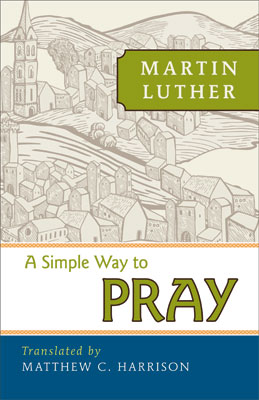
Daily Reflections for the course of the week from which you pick up this post. The material is drawn from drafts I posted on the Emerging Scholars Network Facebook Wall as part of a class on Christian Devotional Classics at Evangelical Seminary. Click here for a free copy of A Simple Way to Pray (. . . for Master Peter the Barber). Please email me know if you use the second section to stimulate campus discussion (e.g., brown bag lunch discussion group). I am particularly interested in suggestions on revisions for use in that context.
1. ‘[Martin] Luther’s instructions for prayer can be boiled down to this: pray the catechism. It has been said that the ‘Small Catechism’ is the only catechism in the world that can be prayed, and this is exactly what Luther intends. The catechism is not just an instruction book, but, as Luther says of the Ten Commandments, a ‘school text, song book, penitential book, and prayer book.'” — Pastor Wolfmueller. “Introduction” to Martin Luther’s A Simple Way to Pray (. . . for Master Peter the Barber) (1535).
For Deeper Reflection: Have you sung and/or “prayed through” a catechism, the Lord’s Prayer, the Ten Commandments, The Apostle’s Creed? If so, have you found such helpful in your devotional life? If not, would you (as Master Peter the Barber) have desire to begin to learn how to do such from “a figure” such as Martin Luther?
Yes, I encourage you to take a few minutes this Sabbath and be blessed by prayerfully considering this short piece by an intense Doctor in Bible (University of Wittenberg): A Simple Way to Pray (. . . for Master Peter the Barber) (1535).[2]
2. “Suddenly, Master Peter had an idea. He could ask his hero, Martin Luther, to teach him how to pray! After all, the great reformer was there, sitting in his very own barber chair, waiting patiently for Peter to cut his hair and give him a shave. . . . ‘Dr. Luther, do you think you could help me learn to pray better?'” — Karisa Schlehr. Free Download: The Barber Who Wanted to Pray. 10/28/2011.
For Deeper Reflection: A telling of the story by R.C. Sproul. Yes, this version is for children, but I still enjoyed the opportunity to try to place myself “in the situation” with the real life “characters”. Note: For the direct link to the audio, click here.
3. A Mighty Fortress Is Our God. Did Martin Luther (1483-1546) write and/or sing A Mighty Fortress Is Our God en route to the Diet of Worms (1521)? Whether or not the hymn was written in 1521 (or the other proposed years of 1527, or 1529), I’m sure Psalm 46 was on his mind. Thank-you to Kris for sharing Chris Rice’s recent version of mt7tEV2thO4″>A Mighty Fortress is Our God for Peace Like a River: The Hymns Project.
http://www.youtube.com/watch?v=mt7tEV2thO4
For Deeper Reflection: What Psalm(s) do you read, pray, and sing as you face challenging examinations?
4. Luther on responding to joyless prayer. “First, when I feel that I have become cool and joyless in prayer because of other tasks or thoughts (for the flesh and the devil always impede and obstruct prayer, I take my little psalter, hurry to my room, or, if it be the day and hour for I, to the church where a congregation is assembled and, as time permits, I say quietly to myself and word-for-word the Ten Commandments, the Creed, and, if I have time some words of Christ or of Paul, or some psalms, just as a child might do. It is a good thing to let prayer be the first business of the morning and the last at night” — Martin Luther, A Simple Way to Pray (. . . for Master Peter the Barber), 3.
For Deeper Reflection: Do you seek to regularly “touch base” with God, letting “prayer be the first business of the morning and the last at night” — praying without ceasing in between (Psalm 1:1-2, Luke 11:1-12, Luke 18:1-8; Ephesians 6:18, I Thessalonians 5:17). What guides your conversation with God? How do you respond when your prayer life becomes joyless? Is it an emergency or ‘just part of life’ — one which you wait to hopefully change while attention is given to other ‘more important matters’?
5. Luther’s ITCP method of prayer. “The Rev. Dr. Matthew C. Harrison, president of The Lutheran Church—Missouri Synod, explains Martin Luther’s ITCP method of prayer, which features four steps: instruction, thanksgiving, confession and prayer.” — Learn Martin Luther’s Simple Way to Pray. LCMS Video Gallery. 5/1/2013.
For Deeper Reflection: Do you have regular pattern or guide for prayer as you begin/end the day, eat meals, practice devotions? What are your thoughts regarding to instruction, thanksgiving, confession and prayer? Note: For free on-line version of Martin Luther’s “Simple Way to Pray” click here.
6. The Protestant Reformation did not occur suddenly in 1517 when Martin Luther tacked his Ninety-five Theses to the church door in Wittenberg . . . the movement towards reform had a long history in the late medieval Church” — Richard J. Woods. Christian Spirituality: God’s Presence Through the Ages. Expanded edition. Maryknoll, NY: Orbis Books, 2006. p.186.
For Deeper Reflection: Do you think of yourself as part of a larger movement — on your campus, in your field, within and/or across ethnicity/culture/gender, as part of the Body of Christ? What reminds you of where you’re “located” . . . provides the very story framing your way of life? Returning to the Word, significant teachings of the Church, and prayer remind us that we are part of the Body of Christ, that we’re part of something bigger — for a little more read Loving God in the Flesh in the Real World (Thomas B. Grosh IV).
Martin Luther (1483 – 1546) wasn’t starting a movement, he was seeking opportunity to share what God was teaching him. What would have happened if there had been fruitful dialogue on campus, in the Church? The conflict epitomizes the “agonizing struggle to recognize authentic interpretations of the Gospel in an often violent encounter between great personalities” (Woods, 55) and continues to significantly shape Christendom. What are the academic, societal, and/or theological discussions most worthy of our investment in dialogue today?
Pray for grace for fruitful dialogue in our disciplines, on our campuses, within and across ethnicity/culture/gender, and as part of the Body of Christ — for more explore Vinoth Ramachandra’s 2012 Henry Martyn Lectures. May we not fill the devil with glee by engaging in attempts at violent resolution — by lack of space at the table, words, use of force . . .
7. “You should also know that I do not want you to recite all these words in your prayer. That would make it nothing but idle chatter and prattle, read word for word out of a book as were the rosaries by the laity and the prayers of the priests and monks. Rather do I want your heart to be stirred and guided concerning the thoughts which ought to be comprehended in the Lord’s Prayer. These thoughts may be expressed, if your heart is rightly warmed and inclined toward prayer, in many different ways and with more words or fewer.
I do not bind myself to such words or syllables, but say my prayers in one fashion today, in another tomorrow, depending upon my mood and feeling. I stay however, as nearly as I can, with the same general thoughts and ideas. It may happen occasionally that I may get lost among so many ideas in one petition that I forego the other six. If such an abundance of good thoughts comes to us we ought to disregard the other petitions, make room for such thoughts, listen in silence, and under no circumstances obstruct them.
The Holy Spirit himself preaches here, and one word of his sermon is far better than a thousand of our prayers. Many times I have learned more from one prayer than I might have learned from much reading and speculation. . . . With practice one can take the Ten Commandments on one day, a psalm or chapter of Holy Scripture the next day, and use them as flint and steel to kindle a flame in the heart. . . . — Martin Luther. A Simple Way to Pray (. . . for Master Peter the Barber), p. 7, 17.
For Deeper Reflection: Martin Luther’s A Simple Way to Pray provides a pattern for learning how to pray — of great benefit not only to children and children of the faith, but to each an every one of us as we seek to follow Christ with our whole life. May our hearts be ready and eager for prayer.
Evening Blessing: Under the care of God the Father, Son, and Holy Spirit. Amen. I give thanks to you, my heavenly Father, through Jesus Christ your dear Son, that you have graciously protected me today, and I ask you to forgive me all my sins, where I have done wrong, and graciously to protect me tonight. For into your hands I commend myself: my body, my soul, and all that is mine. Let your holy angel be with me, so that the wicked foe may have no power over me. Amen.
- What Luther Didn’t Say about Vocation was written to debunk the widespread attribution of this quote to Luther: “The maid who sweeps her kitchen is doing the will of God just as much as the monk who prays—not because she may sing a Christian hymn as she sweeps but because God loves clean floors. The Christian shoemaker does his Christian duty not by putting little crosses on the shoes, but by making good shoes, because God is interested in good craftsmanship.” Comment: I have not had time to do more than an cursory search on this topic. If you have a citation for the quote, please let me know. I’ve heard it used in a number of contexts. ↩
- A Simple Way to Pray (. . . for Master Peter the Barber) is also available in Luther’s Works, vol. 43″ [Devotional Writings II]: 193-211.
Update: 9/15/2013. 3:10 PM. Minor edits.
Tom enjoys daily conversations regarding living out the Biblical Story with his wife Theresa and their four girls, around the block, at Elizabethtown Brethren in Christ Church (where he teaches adult electives and co-leads a small group), among healthcare professionals as the Northeast Regional Director for the Christian Medical & Dental Associations (CMDA), and in higher ed as a volunteer with the Emerging Scholars Network (ESN). For a number of years, the Christian Medical Society / CMDA at Penn State College of Medicine was the hub of his ministry with CMDA. Note: Tom served with InterVarsity Christian Fellowship / USA for 20+ years, including 6+ years as the Associate Director of ESN. He has written for the ESN blog from its launch in August 2008. He has studied Biology (B.S.), Higher Education (M.A.), Spiritual Direction (Certificate), Spiritual Formation (M.A.R.), Ministry to Emerging Generations (D.Min.). To God be the glory!

Leave a Reply